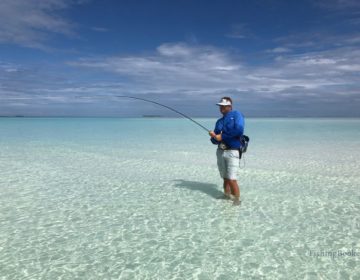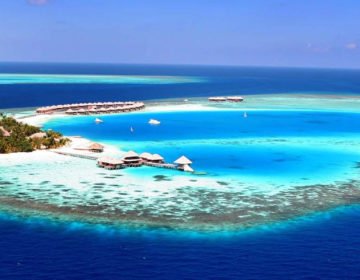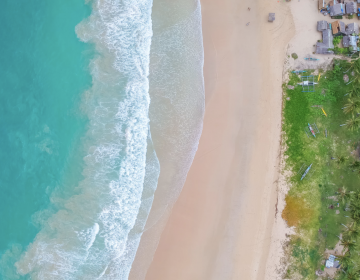Built in the year 1906 by Sultan Mohamed Shamsuddeen III, the Mulee’aage Palace is the official residence of the President of the Maldives. Located in front of the Old Friday Mosque in the ward of Henveiru in the historic center of Malé, the shimmering white palace still shines in the same old glory of its earliest years.
 The Mulee’aage Palace is the official residence of the President of the Maldives.
The Mulee’aage Palace is the official residence of the President of the Maldives.
History
Construction of the Mulee’aage (meaning the ‘new house of Muli’) was commissioned by Sultan Muhammad Shamsuddeen III for his son and heir Prince Hassan Izzuddin and began in 1914. Erected on the site of Mulee’ge, the ancestral home of Shamsuddeen, the building was constructed in a bungalow-style, a trend that was in fashion during the colonial era in Ceylon. The palace was completed in preparation for the return of Prince Hassan Izzuddin to Male’ in 1920 after he finished his studies at the Royal College of Colombo.
Mulee’ge, the ancestral home of Shamsuddeen, was also the home of the Sultan Hasan ‘Izz ud-din (or ‘Dhon Bandaarain’ 1759-66) from his maternal side and it remained with the Huraa Dynasty rulers throughout its history. The last occupant of Mulee’aage was Prince Mulee’ge Manippulhu, who later ascended the throne as Sultan Muhammad Shamsuddeen III in 1892.
Mulee’aage was occupied by Prince Hassan Izzuddin between 1920 and 1934, and it was famous throughout Malé as a place for merriment and gaiety with a variety of music and dance performances organized by the young prince for his entertainment. He was later banished to the isolated southerly island of Fuvahmulah in 1934 after suffering a smear campaign organized by his uncle and cousin where he died in 1938.
Neither Mulee’aage nor Mulee’ge ever served as a Royal Palace, however, the new building is located just a stone’s throw away from the site of the former royal palace, now the Sultan’s Park and the National Museum of Maldives. Most of the buildings in the royal palace grounds were demolished during Ibrahim Nasir’s presidency in the late 1960s.

The Rise and Fall of the First Republic
After Prince Izzudin was banished, Mulee’aage remained abandoned until the second World War, when it was used as the Ministry of Home Affairs by Mohamed Amin Didi. Following the abolition of the Maldivian Monarchy in 1952, the new President Mohamed Amin Didi officially made Mulee’aage the Presidential Palace on January 1, 1953. It later became the Prime Minister’s Office under Ibrahim Faamuladheyri Kilegefaanu following Amin’s oust that year and the restoration of the monarchy under Sultan Muhammad Fareed Didi. (www.wikipedia.com)
The Second Republic
The first president of the second republic, Ibrahim Nasir Rannabandeyri Kilegefan, declared Mulee’aage as the Presidential Palace in 1968, however, he only took temporary residence at Mulee’aage while his own house, Velaanaa’ge, was under construction.
President Maumoon Abdul Gayyoom resided at Mulee’aage for the first 20 years of his presidency, but later commissioned Theemuge to be built and declared it the official Presidential Palace in 1998. Mulee’aage served as the President’s Office and later the Supreme Court during the latter years of Maumoon’s presidency. (www.wikipedia.com)
 President Maumoon Abdul Gayyoom commissioned Theemuge to be built and declared it the official Presidential Palace in 1998.
President Maumoon Abdul Gayyoom commissioned Theemuge to be built and declared it the official Presidential Palace in 1998.
The Third President
After defeating Maumoon Abdul Gayyoom in the Maldives’ first democratic multi-party elections in 2008, Mohamed Nasheed became the third president of the second republic. Nasheed was a strong critic of Maumoon’s government and its alleged overspending. He refused to use Theemuge due to the high costs of maintaining it as a house of residence and stayed at his own house Yaagoothu’ge for the first few months of his presidency.
In 2009 former president Nasheed moved to Mulee’aage once again declaring it the official residence of the Maldivian President. In 2011, Nasheed installed a solar photo-voltaic energy system in the roof of the Mulee’aage with the aim of promoting sustainable energy and sending a global message on climate leadership. After his resignation in 2012, the palace became vacant. (www.wikipedia.com)
 In 2011, Nasheed installed a solar photo-voltaic energy system in the roof of the Mulee’aage with the aim of promoting sustainable energy.
In 2011, Nasheed installed a solar photo-voltaic energy system in the roof of the Mulee’aage with the aim of promoting sustainable energy.
Medhu Ziyaaryai
Medhu Ziyaaryai (literally translated as ‘Central Tomb’) was a part of the original Mulee’aage building, and today, it is separate from the building and an enclave of Mulee’aage. It houses the tomb of Moroccan scholar Abul Barakat Yousef Al-Berberi, who is believed to have introduced Islam to the nation in 1153. (www.wikipedia.com)
 Medhu Ziyaaryai (literally translated as ‘Central Tomb’) was a part of the original Mulee’aage building, and today, it is separate from the building and an enclave of Mulee’aage.
Medhu Ziyaaryai (literally translated as ‘Central Tomb’) was a part of the original Mulee’aage building, and today, it is separate from the building and an enclave of Mulee’aage.
Source: https://en.wikipedia.org/wiki/Muliaage / https://www.maldivestraveller.mv/listings/attractions/mulee-aage



